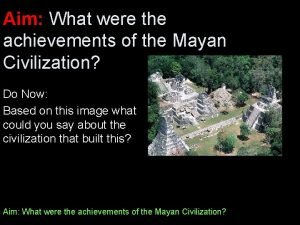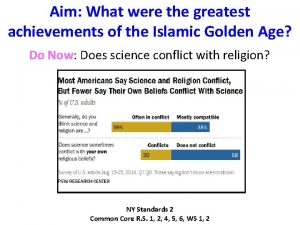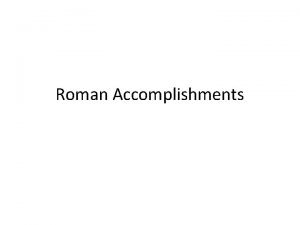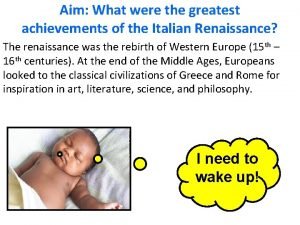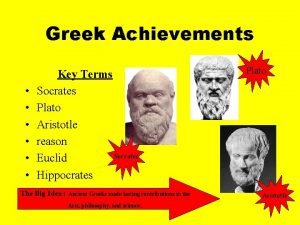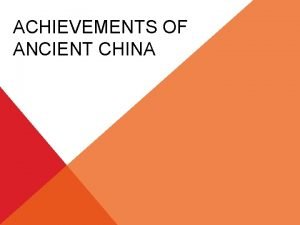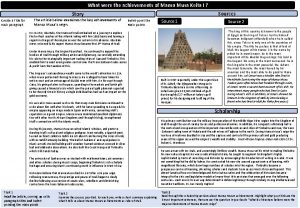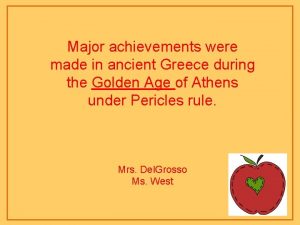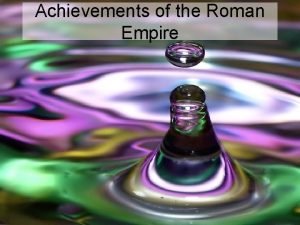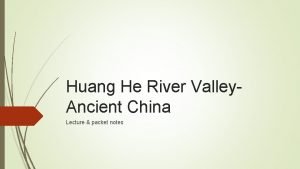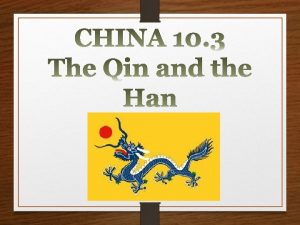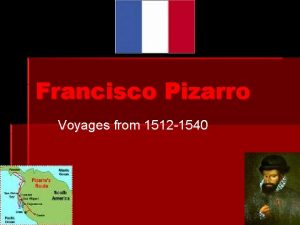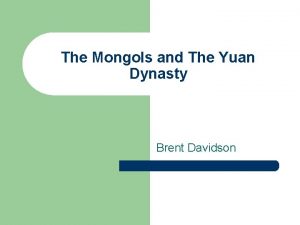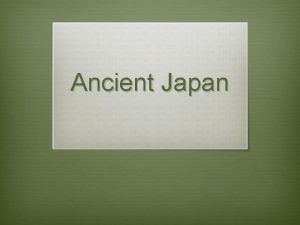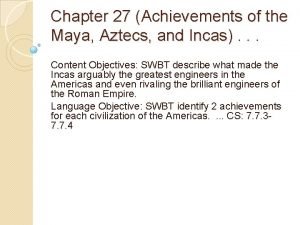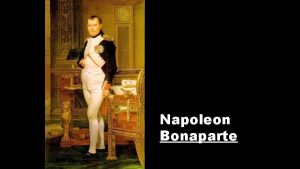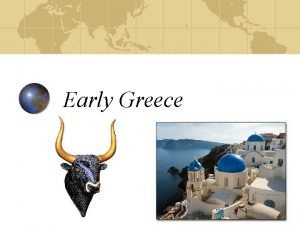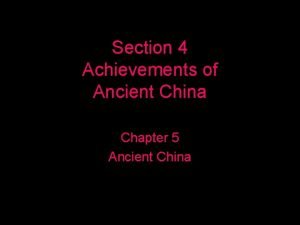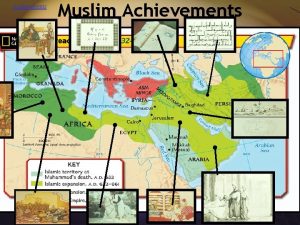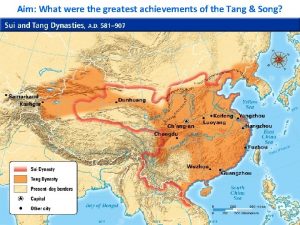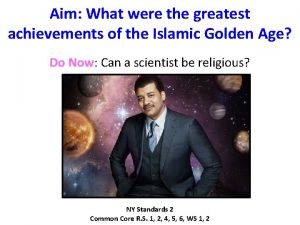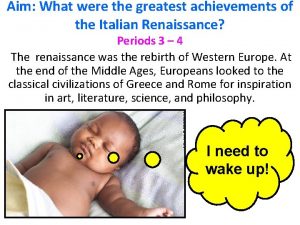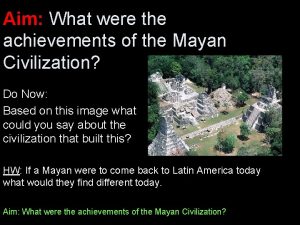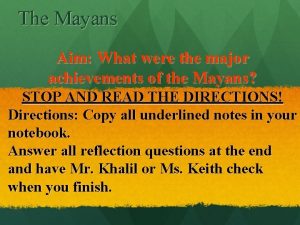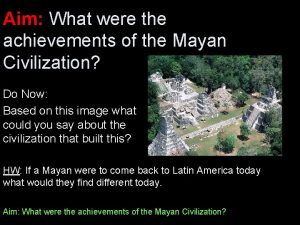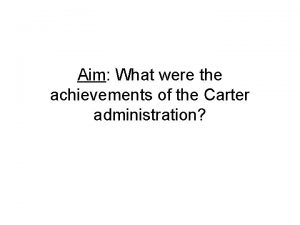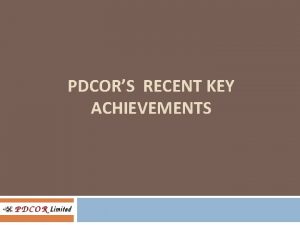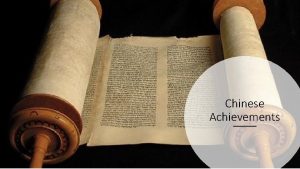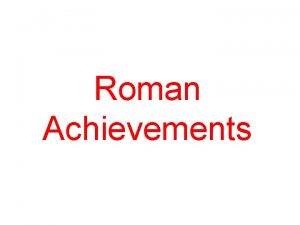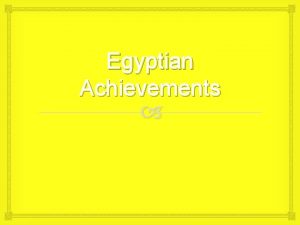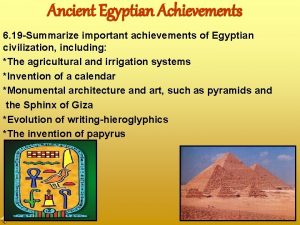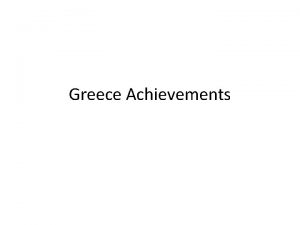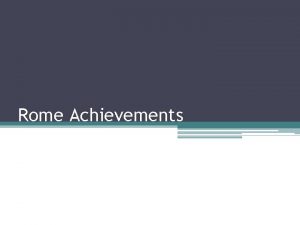Aim What were the greatest achievements of the




























- Slides: 28

Aim: What were the greatest achievements of the Islamic Golden Age? Period 3: 600 CE – 1450 CE Left: A doctor visits a patient in this vibrantly colorful miniature from a 14 th-century Persian copy of the Maqamat. Right: A medieval Western European being bled for medical purposes.


I Age of Conquest and Division A) Muhammad, the founder and prophet of Islam died in 632 CE. When he died he had not named a successor, which led to a major division within Islam. B) The Sunni branch believes that the first four caliphs--Mohammed's successors-rightfully took his place as the leaders of Muslims. C) Shiites, in contrast, believe that only the heirs of the fourth caliph, Ali, are the legitimate successors of Mohammed. D) Sufis developed separately from Shiites and Sunnis. Through meditation they try to have a spiritual connection to Allah. Whirling dervishes twirl, often for hours, as an act of ecstatic devotion.


Age of Conquest and Division Continued… F) Islam offered the possibility of an end to the feuds amongst the tribal peoples of Arabia with the umma (community of the faithful). Also all believers were seen as equal under Allah. G) Payment of the zakat, a tax for charity, was obligatory. H) Sharia law (Islamic law) regulated all aspects of a Muslim’s life. I) “People of the book” applied to Jews and Christians, and occasionally even Zoroastrians; they were monotheistic and read the Old Testament (Jews) and the New Testament (Christians). They all had to pay a tax, but they were not forced to convert. Must-Know Vocab: Caliphate: The government of a Muslim Dynasty or Empire Dar Al-Islam: Any land under Islamic control Emirate/Sultanate: Subordinate member state of a caliphate

Age of Conquest and Division Continued…

VIII Islamic Dynasties Umayyad Empire (661 Conquered North Africa, Iberia (Spain) -750 CE) and Palestine. Capital at Damascus. Built the Dome of the Rock on the Temple Mount (former site of the Jewish Temple). Allowed freedom of religion to “people of the book” if they paid a tax. Abbasid Dynasty (750 Conquered the Umayyad Empire. Moved -1258 CE) the capital to Baghdad. Mongols executed the last Abbasid caliph. Tamerlane’s Empire (1398 – 1405) Tamerlane conquered India and created his capital at Samarkand. Death toll approx. 19 million. He died in 1405 before he could conquer the Ming Dynasty in China.

Islamic Dynasties Continued… Ottoman Empire (1299 – 1922) “Gunpowder Empire” Begun by Osman. In 1453 the Ottomans captured Constantinople and renamed it Istanbul. Rulers were called Sultans. The Ottomans forced many Christian boys to convert to Islam and serve in the army; they were called janissaries. Most famous ruler was Suleiman the Magnificent (1495 – 1566) was also known as “the lawmaker”. Conquered Hungary and Vienna in Eastern Europe. Built the Blue Mosque in Istanbul, hammams (Turkish baths), and schools. Famous for his law code and poetry. Expanded navy. Sultan Mehmed II the Conqueror's Law of Governance: "Any of my sons ascend the throne, it acceptable for him to kill his brothers for the common benefit of the people. The majority of the ulama (Muslim scholars) have approved this. . . "




IX International Muslim Trade A) In the Middle Ages, trade in Western Europe had fallen. However. . B) During the same time, Muslim led camel caravans crossed the Sahara and the Silk Road.

X Achievements in the Arts and Manufacturing A) Manufacturing: 1. Steel swords from Spain 2. Leather from Iberia (modern day Spain) 3. Cotton textiles from Egypt 4. Carpets from Persia

Leather Manufacturing In Morocco

Arts and Manufacturing Continued… B) As Muslims are forbidden from creating images of people or animals, they developed a new style of art known as arabesque; geometric patterns that resemble floral shapes. For the same reason, Muslims also developed a form of calligraphy.

Blue Arabesque Tiles, Samarkand

Blue Mosque, Istanbul

The Alhambra Palace, Grenada, Spain

Turkish Hamam A relic from ancient Roman Bathhouses

Arts Continued… C) One of the most famous works of Islamic literature is The Thousand One Nights, author unknown. The Plot: King Shahryar’s wife is unfaithful to him. He has her killed. Then, loathing all women, he marries and kills a new wife each day afterward. Shahrazad, a daughter of the King’s vizier, insists on marrying him so to end his terror. She begins to tell the king a tale, leaving it incomplete at the end of the night…which she continues to do until she has given birth to his children, when he finally abandons his plan.

XI Math and Science A) Muslim scholars translated Greek, Roman, and Hindu texts, preserving them. B) Muslims spread the Hindu number system (Arabic numerals) to Europe C) Al-Khwārizmī improved upon ancient Greek algebra D) Built astronomical observatories Persian Telescope, 13 th century

Math and Science Continued… The purpose of algebra according to Al-Khwarizmi was to solve problems of inheritance, legacies, partition, lawsuits, trade, measuring of lands, and the digging of canals. Impact on Western Europe: His algebra book became the standard mathematical text at European universities until the 16 th century. He also made important contributions to astronomy, and developed the first quadrant (an instrument used to determine time by observations of the Sun or stars).

Math and Science Continued… D) Ibn Sina wrote the Canon on Medicine; an encyclopedia of all medical knowledge. He created a system of medicine that today we call “holistic” in which physical and psychological factors, drugs, and diet were combined in treating patients. E) Funded by charity, public hospitals treated the sick, housed the mentally ill, and provided shelter to the elderly. Jewish and Christian doctors, in addition to Muslim physicians, worked in these institutions. Left: Cataracts Surgery Right: Cauterization for a tooth

Ibn Battuta Travels in Asia and Africa 1325 – 1354 (A Muslim Scholar and Explorer from Tangier, Morocco) On the morrow he rode with me and we reached [Malaga], which is one of the largest and most beautiful towns of Andalusia [Iberia, modern Spain]… I saw grapes… and its ruby-colored pomegranates have no equal in the world. . . At Malaqa there is manufactured excellent gilded pottery, which is exported to the most distant lands… the court of the mosque is of unequalled beauty, and contains exceptionally tall orange trees. Thence I went to on the city of Gharnata [Granada]… I met at Gharnata a number of its distinguished scholars and the principal Shaykh, who is also the superior of the Sufi orders… He showed me the greatest honor and went with me to visit the hospice…



Focus Questions 1. How did post-classical Islamic caliphates gain, consolidate, maintain and lose their power? 2. Why did Islam not spread further into Western Europe beyond Iberia? 3. How would history have been different had Islam spread to Western Europe? 4. How/why did Muslims preserve knowledge of the classical world? 5. Did Islam limit or help advance knowledge and achievements? 6. How did the role of women change from pre-Islamic Arabia to post. Islamic Arabia? 7. How did the split of Shia and Sunni Muslims effect the development of Islamic civilization?

Key Vocabulary ü ü ü ü Abbasid Dynasty Al-Khwārizmī Arabesque Arabic numerals Caliphate Cataracts surgery Dar Al-Islam Dome of the Rock Emirate Haddith Ibn Sina Imam Janissaries Muhammad Muslims ü ü ü Ottoman Empire People of the Book Sufi Suleiman the Magnificent Sultanate Sunni Shia Tamerlane Thousand One Nights Umayyad Dynasty Umma Zakat
 Mayan civilization accomplishments
Mayan civilization accomplishments Greatest achievement of the ottoman empire
Greatest achievement of the ottoman empire Roman engineering achievements
Roman engineering achievements Leonardo da vinci greatest achievements
Leonardo da vinci greatest achievements Plato greatest achievements
Plato greatest achievements Achievements of the shang dynasty
Achievements of the shang dynasty What were mansa musa's most important achievements
What were mansa musa's most important achievements Pericles achievements
Pericles achievements Was were going to future in the past
Was were going to future in the past Transforming moments setting
Transforming moments setting Roman empire achievements
Roman empire achievements Zhou dynasty achievements
Zhou dynasty achievements Han wudi achievements
Han wudi achievements Industria achievements
Industria achievements Francisco pizarro voyages map
Francisco pizarro voyages map Yuan dynasty map
Yuan dynasty map Prince henry the navigator achievements
Prince henry the navigator achievements Greek achievements in architecture
Greek achievements in architecture Achievements of namami gange project
Achievements of namami gange project Ramses ii and moses
Ramses ii and moses Rntcp covers the whole country since
Rntcp covers the whole country since Japanese achievements
Japanese achievements Maya achievements
Maya achievements Napoleon life timeline
Napoleon life timeline Bill gates achievements and awards
Bill gates achievements and awards Battle of issus map
Battle of issus map Location
Location Han dynasty achievements
Han dynasty achievements Setting of things fall apart
Setting of things fall apart
